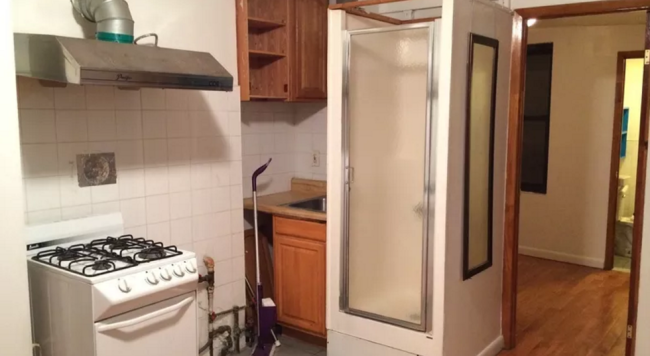5 reasons that 40-square-foot Williamsburg apartment is almost certainly illegal
Seemingly not a week goes by without a new story reminding us of the depths to which desperate New Yorkers will sink in order to find a place to live. (Remember the great shower-in-kitchen uproar back in March?) This time around, the New York Times has brought us the unsettling tale of a 25-year-old musician named Jack Leahy who's shelling out $450/month to live in a 40-square-foot crawl space above a Williamsburg performance venue.
The "apartment," which is only accessible by a ladder, also requires this intrepid 25-year-old to minimally use a shared kitchen and bathroom located in the building's office area. People have rightfully been outraged since the story first started circulating, and even the Times notes that the first question Leahy usually gets about the apartment is whether or not the setup is legal.
In a word? No.
Pretty much anyone could look at his windowless sleeping cubby and know that it's probably not kosher, but for the sake of argument, we thought we'd explore all the reasons why this is such an unacceptable living situation. Below, five different ways this crawl space violates NYC housing laws:
No certificate of occupancy
This is really the big one here, and the legal issue from which everything else stems. The Certificate of Occupancy is a document issued by the Department of Buildings granting a building status as a legal residence, and the landlord the right to collect rent. Given that Leahy's crawl space is located in a theater, it's highly unlikely that the building has permission to legally to house tenants.
"In order to be entitled to a Certificate of Occupancy, a building has to meet all these different standards," says real estate attorney Cathy Grad, referring to the standards laid out in the Housing Maintenance Code and Multiple Dwelling Law (more on that below.) "Since the building is a theater, you have to assume that the C of O is for commercial use, not residential." And unlike certain loft buildings that earned residential status under the Loft Law, says Grad, this space almost certainly couldn't become a legal dwelling given its lack of windows, air, safe exits, and the like.
The one silver lining is that Leahy could feasibly have cause to withhold rent, since landlords do need a C of O to legally collect money from renters.
Lack of windows
One of the first standards for a legal bedroom in NYC is that the room have a window, and a certain amount of light and ventilation. Suffice it to say that Leahy's windowless crawl space doesn't make the cut.
"It's illegal, it's not a living space," says tenants rights attorney Sam Himmelstein. "Bedrooms and sleeping spaces need a certain ratio of square footage to windows." Though windowless "bedrooms" are a relatively common phenomenon in the world of sketchy NYC rentals, rest assured that from a legal perspective, they're an absolute no-go.
It's just too small
This may come as a surprise to anyone who rents a cramped studio, but legally speaking, there really is such a thing as a New York apartment that's too small to be acceptable. And this one fits the bill.
"The Housing Code says that a tenant occupying an apartment shall have a liveable area of not less than 80-square feet," says Himmelstein, who adds that these rules date back to the days of Jacob Riis, when many New Yorkers lived in horrible tenement conditions. "So he's living in half of what the city considers a liveable space." The same code also requires ceilings to be at least eight feet high, and the Times notes that after the entryway, the "headroom decreases to about five feet" in Leahy's living space.
It's not a legal SRO
When he's not busy climbing the ladder to his crawl space, the Times writes that Leahy shares a kitchen and bathroom with seven other people who live in the building, a setup that sounds similar to a classic Single Room Occupancy building (or SRO).
But even if this theater did have a Certificate of Occupancy and legal standing to operate as an SRO, it wouldn't be up to snuff: Housing Code stipulates that there be at least one bathroom per six residents.
The ladder entrance is a fire hazard
Besides being an ungodly hassle, the fact that Leahy can only access his living space via a ladder is, unsurprisingly, a significant safety hazard.
"If there's a fire, how's he getting out?" asks Grad. "The fire code is part of the requirements to obtain the C of O." Given that the fire code requires an unobstrocted "vertical and horizontal" route to the "means of egress" in a residence—e.g. the exit—a rickety ladder doesn't exactly make the cut.
If you start scrolling through city housing codes, these issues are just the tip of the iceberg as far as how deeply wrong this "quirky" living situation really is. "The landlord could face serious penalties for allowing this," says Himmelstein. "This is one instance where I think the city should figure out which building it is and issue a vacate order."
You Might Also Like




























